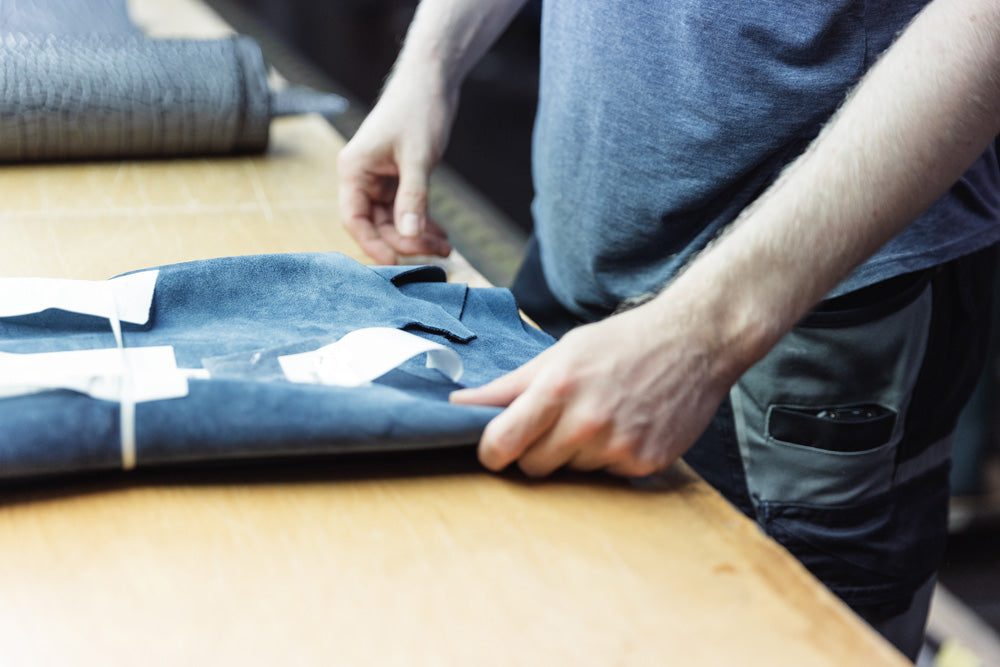BONDING LEATHER
Gluing leather is not as difficult as you might think. Holes or tears are often sewn rather than glued. Sewing, however, takes a lot more skill and effort. Whether it's faux leather or real leather, you can repair damage in no time with different adhesives. Major damage should rather be sewn or repaired by specialists, but minor damage can definitely be repaired without much effort. Leather is a natural product and therefore it does not accept any glue. In the worst case, the glue will not adhere properly and the repaired hole or cracks will reopen. However, the adhesive may also leave stains or streaks. That's why you should use an adhesive that is specifically made for your leather goods. Gluing leather ensures that the holes or cracks are closed and the leather goods become fully functional again.
GLUING LEATHER - WITH WHAT
If you want to glue leather, you must use an adhesive that meets certain requirements. After the glue has dried, it must be stable, but it must not be too tight, because the leather still needs to move. Imagine you have a fancy leather jacket that has a hole in the sleeve. You decide to glue the hole, but you use an adhesive that is very immobile after curing. This will limit your freedom of movement when wearing the glued jacket. Another important requirement for the adhesive is that it must not soak through the material even after a long time. A leather jacket with adhesive stains would mean a great loss of value. For these reasons, you should definitely choose an adhesive very carefully.
GLUING LEATHER TO LEATHER - INSTRUCTIONS
If you want to glue leather on the sofa, in the car, on shoes or mend leather, then you should pay attention to some things. First of all, you need to prepare your work. Make sure that you have good ventilation. Also, you should not work on delicate surfaces, otherwise they may be damaged. You can work on a dining table, for example, but be sure to use an additional surface to protect the table. It is also very important that the leather is cleaned before the repair. If necessary, you can also go over the surface to be repaired with a sandpaper before cleaning and repairing it. The cleaning can be done with some curd soap and a damp cloth. Afterwards, you should dry the leather before you continue. In the next step you can start with the actual repair. To do this, simply apply the glue, and you should apply the glue on both leather parts.
You can protect yourself while gluing leather by wearing latex gloves. You should make sure that you press the two pieces of leather firmly together. If necessary, you can also maintain the pressure with rubber bands, power tape or staples. It usually takes one to three hours for the adhesive to dry. However, it takes quite a while for the adhesive to reach its final strength. The rule of thumb is that three millimeters of adhesive takes about 24 hours for the adhesive to reach its final strength. After the adhesive has reached its final strength, you should clean your work surface thoroughly. You can clean all surfaces with the help of alcohol or methylated spirits. You can carefully remove adhesive residue with a pointed object, such as a glass scraper. If you have any glue left over, you should store it safely in a tightly closed container. The storage location should not exceed room temperature.
THIS IS THE RIGHT ADHESIVE FOR LEATHER
Gluing leather works with many different adhesives. So you should consider which glue would be best for your leather goods. On the one hand, there is the contact adhesive, with which you can glue leather, which is hardly permeable to solvents. Leather shoes can be glued to the leather sole with this adhesive. The solvent must be allowed to evaporate before joining. After about a quarter of an hour, the surface will no longer feel sticky and then the sole should be pressed firmly to the shoe. An alternative to the contact adhesive are the spray adhesives, which can be simply applied to the leather. No other tools are needed for this. These spray adhesives are characterized by a short flash-off time and a long bonding span.
If you want to glue your leather goods not only to other leather goods, but also to metal or wood, for example, you can use solvent adhesives for this purpose. Before gluing leather, be sure to test the adhesive. Solvent adhesives can lead to unattractive discoloration. Thin, solid-colored leather goods such as suede or aniline leather are particularly susceptible to discoloration. Dispersion adhesives have similar properties to solvent adhesives. However, these adhesives are dispersed in water. The comparatively long flash-off times can be shortened with the aid of infrared or hot air, for example with a hair dryer. These adhesives are very water-resistant and flexible, which is why you can use them to glue leather that is inside the shoe. When gluing leather, you must therefore pay attention to the properties that your adhesive should have.
THIS IS HOW YOU CAN REPAIR SMALL DAMAGES
Gluing small damages such as in leather shoes is easily possible with the right glue. Optimally, you should use a waterproof adhesive to glue leather. Gluing leather from shoes is not so easy, because the adhesive is exposed to a lot of stress. The combination of sweat, friction and heat will put a lot of strain on the adhesive. For this reason, you should not use an everyday glue, but a special glue that is suitable for gluing leather.
If you want to repair your leather shoes, you must first clean your shoes and then dry them well. Then select a suitable adhesive and apply it to the desired area. After about ten minutes, the solvent should have evaporated. This is the moment when an adhesive film should have formed on the leather surfaces. You can easily test this by gently tapping the adhesive with your finger. No glue should stick to your finger. If the solvent has not yet evaporated, you can simply wait a few minutes. In the next step, you simply press both surfaces firmly together. Now you have to wait for about a day until the glue has reached its final strength. When gluing leather, you should make sure that you test whether the glue discolors the leather before the repair.
THIS IS HOW YOU CAN REPAIR LARGE DAMAGES
You can also treat larger damages with glue. You can either use liquid leather or a leather patch to glue on. You can easily glue cracks or holes. However, you often have to glue the leather so that you can apply the liquid leather afterwards. For larger holes, you should also use a patch. It is important that the liquid leather is also the same color as the leather. Otherwise, there will be unsightly color differences after the repair. Also, the liquid leather and the leather glue will restore the function, but there will still be a visible spot where the hole or tear was. Repairing leather goods is recommended because it is cheaper and more environmentally friendly than buying new.


